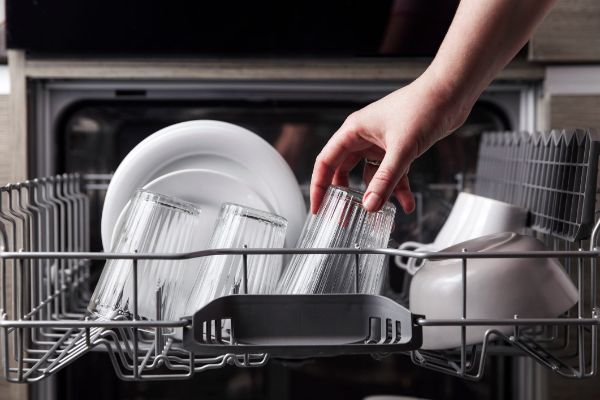After a thorough cleaning cycle, the next step in achieving spotless dishes is the drying process. Dishwashers offer two primary methods for drying: condensation drying and heat drying. Each method comes with its own set of benefits and considerations.
In this blog post, we will explore the important factors to consider when choosing between dishwasher condensation drying and heat drying, helping you make an informed decision for perfectly dry and ready-to-use dishes.
Table of Contents
Condensation Drying
Condensation drying is a popular drying method used in many modern dishwashers. Here’s how it works:
- Rinse Cycle: The dishwasher sprays hot water on the dishes during the final rinse cycle.
- Evaporation: As the hot water comes into contact with the dishes, it evaporates, creating steam inside the dishwasher.
- Cool Surface: The steam then condenses on the cool surfaces of the dishwasher, such as the stainless steel or plastic tub.
- Water Removal: The condensed steam drips down and is drained away, leaving the dishes dry.
Advantages of Condensation Drying
- Energy Efficiency: Condensation drying uses less energy compared to heat drying, as it relies on the residual heat from the wash cycle to evaporate the water.
- Delicate Item Safety: Condensation drying is gentler on delicate items, such as plastic containers, as it avoids exposing them to high temperatures that can cause warping or damage.
Considerations for Condensation Drying
- Longer Drying Time: Condensation drying can take longer to complete compared to heat drying, as it relies on the natural cooling and evaporation process.
- Potential Residual Moisture: In some cases, condensation drying may leave a slight amount of residual moisture on certain materials, such as glassware or ceramics. However, this is often minimal and can be easily addressed by allowing the dishes to air dry for a short time.
Heat Drying
Heat drying, also known as thermal drying, is another commonly used method in dishwashers. Here’s how it works:
- Rinse Cycle: Similar to condensation drying, the dishwasher sprays hot water on the dishes during the final rinse cycle.
- Heating Element: After the rinse cycle, a heating element inside the dishwasher increases the temperature to dry the dishes.
- Forced Air: The heated air circulates inside the dishwasher, drying the dishes by evaporating the water.
- Venting: The moist air is then vented out of the dishwasher, leaving the dishes dry.
Advantages of Heat Drying
- Faster Drying Time: Heat drying typically offers faster drying times compared to condensation drying, thanks to the direct application of heat.
- Thorough Drying: Heat drying is effective at thoroughly drying dishes, particularly on materials that are prone to retaining moisture, such as glassware.
Considerations for Heat Drying
- Energy Consumption: Heat drying consumes more energy than condensation drying due to the use of the heating element.
- Delicate Item Sensitivity: Heat drying may not be suitable for delicate items or materials sensitive to high temperatures, as it can potentially cause damage or distortion.
Conclusion
Choosing between dishwasher condensation drying and heat drying depends on your priorities and preferences. Condensation drying offers energy efficiency and gentle drying for delicate items, although it may take longer and leave minimal residual moisture. Heat drying provides faster and more thorough drying, but consumes more energy and may not be suitable for delicate materials.
Consider the specific requirements of your dishes, your energy-saving goals, and the dishwasher’s capabilities when making your decision. With the right drying method, you can enjoy perfectly dry and ready-to-use dishes every time you run your dishwasher. If you value energy efficiency and have a mix of delicate and regular dishes, condensation drying may be the ideal choice. On the other hand, if you prioritize fast and thorough drying and are confident that your dishes can withstand higher temperatures, heat drying may be the better option for you.
It’s worth noting that many modern dishwashers offer a combination of both drying methods, allowing you to choose the most suitable option for each wash cycle. This flexibility can provide the best of both worlds, giving you the ability to switch between condensation drying and heat drying based on your specific needs.
Additionally, to optimize the drying performance regardless of the chosen method, consider the following tips:
- Load Placement: Properly arrange your dishes to ensure adequate airflow during the drying process. Avoid overcrowding, which can hinder the drying efficiency.
- Empty Bottom Rack First: If using condensation drying, start unloading the bottom rack first, as it typically retains more moisture due to its proximity to the dishwasher’s cool surfaces.
- Open the Dishwasher Door: Once the wash cycle is complete, open the dishwasher door slightly to allow air circulation and aid in the drying process. This is particularly helpful when using condensation drying.
- Use Rinse Aid: Adding a rinse aid to your dishwasher can enhance the drying performance by reducing water spots and promoting faster drying.
- Patience: Regardless of the drying method, exercise a bit of patience before unloading your dishes. Allow them to cool down for a few minutes, as this can help prevent any residual moisture from evaporating, leaving you with perfectly dry dishes.
Ultimately, the decision between dishwasher condensation drying and heat drying depends on your specific needs, priorities, and dishwasher capabilities. Consider factors such as energy efficiency, drying time, delicacy of your dishes, and personal preferences.
By understanding the advantages and considerations of each method, you can confidently choose the best drying option to ensure spotless and dry dishes every time you run your dishwasher.

